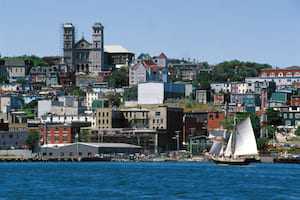|
This article combines all information available on Canada's provinces and territories relating to driving in Canada as a visitor, a student, a temporary or permanent resident.
Depending on which country you are from, you might be able to just exchange your home country's driving licence for a Canadian one without taking knowledge and road tests. |
What to Prepare Before Landing in Canada
Before arriving in your province/territory, you should take the time to familiarize yourself with road signs and rules of driving. It can be quite different from home. Driving in winter can be a real hassle, so please drive with caution or take driving lessons.
You should also apply for an International Driver's Permit in your home country before leaving. It will save you the trouble of translating your driving licence if not in French (only acceptable in some provinces/territories) or English.
You should also get a copy of your driving history from your home country’s licensing authority (in English or French). This will help when you’re applying for a driver's license in Canada, as it can get you driving experience credits when exchanging your licence.
You should also apply for an International Driver's Permit in your home country before leaving. It will save you the trouble of translating your driving licence if not in French (only acceptable in some provinces/territories) or English.
You should also get a copy of your driving history from your home country’s licensing authority (in English or French). This will help when you’re applying for a driver's license in Canada, as it can get you driving experience credits when exchanging your licence.
Please visit this link to understand the different classes for licences (Class 5 for automobiles).
How to get a driver's licence for the first time in Canada
In most provinces, you will need to go through was is called a Graduated Licensing Program. There are generally three steps:
- Take a knowledge written exam (and sometimes eye test). Upon succeeding, you will get a Learner's Permit. You cannot drive alone with this permit, you will always have to be accompanied by an experienced driver (with a full licence).
- After one year of practice, you will be able to take a road test to get an intermediate permit. You can drive alone, but you are not allowed to use any electronic device (even hands-free) and to have any alcohol or drug in the system.
- After one to two year of driving, you will be allowed to take the full licence road test.
How to get exchange your driver's licence into a Canadian one
Please click on the province/territory you are interested in and you will find the necessary information.
Alberta
Visitors, Students, and SAWP foreign workers
If you are (i) visiting, (ii) going to study, or (iii) a temporary foreign workers under the Seasonal Agricultural Worker Program (SAWP) in Alberta, and are from outside Canada, you must hold your valid home country driving licence and an International Driver's Permit to drive in Alberta. It is recommended to have a certified translation of your driver's licence if not in English.
You may drive for up to one year, but if you exit the country and returned, the one-year timeline begins again.
Temporary Foreign Workers and Permanent Residents
If you are (i) a permanent resident of Alberta, or (ii) a temporary foreign worker with a work permit that does not state "Does Not Confer Temporary Resident Status", you may be able to change your home country driving licence to a Class 5 or Class 5L (Learner) licence.
For more information, please visit the Alberta Government website.
If you are (i) visiting, (ii) going to study, or (iii) a temporary foreign workers under the Seasonal Agricultural Worker Program (SAWP) in Alberta, and are from outside Canada, you must hold your valid home country driving licence and an International Driver's Permit to drive in Alberta. It is recommended to have a certified translation of your driver's licence if not in English.
You may drive for up to one year, but if you exit the country and returned, the one-year timeline begins again.
Temporary Foreign Workers and Permanent Residents
If you are (i) a permanent resident of Alberta, or (ii) a temporary foreign worker with a work permit that does not state "Does Not Confer Temporary Resident Status", you may be able to change your home country driving licence to a Class 5 or Class 5L (Learner) licence.
- If your driver's permit is from the following countries: "Australia, Austria, Belgium, France, Germany, Isle of Man, Japan, Netherlands, Republic of Korea, Switzerland, Taiwan, United Kingdom, United States", you can exchange it to a Class 5 Alberta driver's licence (or Class 6 depending on the country) if you have more than 2 years of driving experience. If less, you might be issued a Class 5L licence.
- If your country is not on the list, you will need to pass a knowledge and road tests. You will need to visit a registry agent with your home country's permit and the registry will check what licence Class you will be issued. Depending on your years of experience and home country, you might be authorized to pass the tests for either a Class 7, a Class 5L or a Class 5 driver's licence.
For more information, please visit the Alberta Government website.
British Columbia
Visitors
If you are visiting British Columbia and are from outside Canada, you must hold your valid home country driver's licence and a certified translation of your driver's licence if not in English, by an ICBC approved translator.
You may drive for up to six months as a visitor.
Students
If you are studying in British Columbia and are from outside Canada, you must hold your valid home country driver's licence and a certified translation of your driver's licence if not in English, by an ICBC approved translator.
You may drive for the duration of your studies, as long as you remain a full-time student.
SAWP foreign workers
If you are a foreign worker under the Seasonal Agricultural Worker Program (SAWP) in British Columbia, you must hold your valid home country's permit and a certified translation of your driver's licence if not in English, by an ICBC approved translator.
You may drive for up to 12 months during your stay. If you exit the country and returned, the one-year timeline begins again.
Residents
If you are a new resident of British Columbia, you may be able to change your home country driving permit to a Class 5 licence. You can however drive up to 90 days after taking residency, and will have to change your home country's driver's licence before that.
When you get your new British Columbia driver's licence, you will need to surrender your previous licence.
For more information, please visit the ICBC website.
If you are visiting British Columbia and are from outside Canada, you must hold your valid home country driver's licence and a certified translation of your driver's licence if not in English, by an ICBC approved translator.
You may drive for up to six months as a visitor.
Students
If you are studying in British Columbia and are from outside Canada, you must hold your valid home country driver's licence and a certified translation of your driver's licence if not in English, by an ICBC approved translator.
You may drive for the duration of your studies, as long as you remain a full-time student.
SAWP foreign workers
If you are a foreign worker under the Seasonal Agricultural Worker Program (SAWP) in British Columbia, you must hold your valid home country's permit and a certified translation of your driver's licence if not in English, by an ICBC approved translator.
You may drive for up to 12 months during your stay. If you exit the country and returned, the one-year timeline begins again.
Residents
If you are a new resident of British Columbia, you may be able to change your home country driving permit to a Class 5 licence. You can however drive up to 90 days after taking residency, and will have to change your home country's driver's licence before that.
- If your driving permit is from the following countries/territories: "Australia, Austria, France, Germany, Guernsey, Isle of Man, Ireland, Jersey, Japan, Netherlands, New Zealand, Republic of Korea, Switzerland, Taiwan, United Kingdom, United States", you can exchange it to a British Columbia Class 5 driver's licence (or Class 6 depending on the country) if you have more than 2 years of driving experience. If less, you might need to go through the graduated licensing program (GLP).
- If your country is not on the list, you will need to pass a knowledge and road tests. With two years' of driving experience, you will need to take the Class 5 road test. If less, you will have to go through the graduated licensing program (GLP).
When you get your new British Columbia driver's licence, you will need to surrender your previous licence.
For more information, please visit the ICBC website.
Manitoba
Visitors
If you are visiting Manitoba and are from outside Canada, you must hold your valid home country driver's licence and (i) a certified translation of your driver's licence if not in English or French, by an official translator, or (ii) an International Driver's Permit.
You may drive for up to three months as a visitor.
Students and Residents
If you are a student or new resident of Manitoba, you may be able to change your home country driver's permit to a Class 5 licence. You can however drive up to 90 days (see conditions above) after taking residency, and will have to change your home country's driver's licence before that.
For more information, please visit the Manitoba Public Insurance website.
If you are visiting Manitoba and are from outside Canada, you must hold your valid home country driver's licence and (i) a certified translation of your driver's licence if not in English or French, by an official translator, or (ii) an International Driver's Permit.
You may drive for up to three months as a visitor.
Students and Residents
If you are a student or new resident of Manitoba, you may be able to change your home country driver's permit to a Class 5 licence. You can however drive up to 90 days (see conditions above) after taking residency, and will have to change your home country's driver's licence before that.
- If your driving permit is from the following countries/territories: "Austria, France, Germany, Isle of Man, Northern Ireland, Ireland, Republic of Korea, Switzerland, Taiwan, United Kingdom, United States", you can exchange it to a Manitoba Class 5 driver's licence (or Class 6 depending on the country).
- If your country is not on the list, you will need to pass a knowledge and road tests. Before taking these tests you must register as a Manitoba Public Insurance customer, through a Service Centre or an Autopac Agent.
For more information, please visit the Manitoba Public Insurance website.
New Brunswick
Visitors
If you are visiting New Brunswick and are from outside Canada, you must hold your valid home country driving licence and (i) a certified translation of your driver's licence if not in English, or (ii) an International Driver's Permit.
You may drive for up to three months as a visitor.
Students
If you are studying in New Brunswick and are from outside Canada, you must hold your valid home country driving licence and (i) a certified translation of your driver's licence if not in English, or (ii) an International Driver's Permit.
You may drive for the duration of your studies, as long as you remain a full-time student.
Residents
If you are a new resident of New Brunswick, you may be able to change your home country driver's permit to a Class 5 licence. You need to change your driver's licence a soon as possible.
For more information, please visit the Government of New Brunswick website.
If you are visiting New Brunswick and are from outside Canada, you must hold your valid home country driving licence and (i) a certified translation of your driver's licence if not in English, or (ii) an International Driver's Permit.
You may drive for up to three months as a visitor.
Students
If you are studying in New Brunswick and are from outside Canada, you must hold your valid home country driving licence and (i) a certified translation of your driver's licence if not in English, or (ii) an International Driver's Permit.
You may drive for the duration of your studies, as long as you remain a full-time student.
Residents
If you are a new resident of New Brunswick, you may be able to change your home country driver's permit to a Class 5 licence. You need to change your driver's licence a soon as possible.
- If your driver's permit is from the following countries/territories: "Australia, Austria, Belgium, Denmark, France, Germany, Isle of Man, Ireland, Italy, Japan, Netherlands, New Zealand, Norway, Portugal, Scotland, Republic of Korea, Spain, Sweden, Switzerland, Taiwan, United States, Wales", you can exchange it to a New Brunswick Class 5 driver's licence (or Class 6 depending on the country).
- If your country is not on the list, you will need to take a full driver licence examination, which includes a knowledge, vision, and road tests.
For more information, please visit the Government of New Brunswick website.
Newfoundland and Labrador
Visitors
If you are visiting Newfoundland and Labrador and are from outside Canada, you must hold your valid home country driving licence.
You may drive for up to three months as a visitor.
Students
If you are studying in Newfoundland and Labrador and are from outside Canada, you must hold your valid home country's permit.
You may drive for up to three months as a student. You will have to exchange your driving licence to a Newfoundland and Labrador licence (see below).
Residents
If you are a new resident of Newfoundland and Labrador, you may be able to change your home country driver's permit to a Class 5 licence. You need to change your driver's licence within 3 months of taking residency.
For more information, please visit the Government of Newfoundland and Labrador website.
If you are visiting Newfoundland and Labrador and are from outside Canada, you must hold your valid home country driving licence.
You may drive for up to three months as a visitor.
Students
If you are studying in Newfoundland and Labrador and are from outside Canada, you must hold your valid home country's permit.
You may drive for up to three months as a student. You will have to exchange your driving licence to a Newfoundland and Labrador licence (see below).
Residents
If you are a new resident of Newfoundland and Labrador, you may be able to change your home country driver's permit to a Class 5 licence. You need to change your driver's licence within 3 months of taking residency.
- If your driver's permit is from the following countries/territories: "Austria, France, Germany, Isle of Man, Ireland, Japan, Republic of Korea, Switzerland, United States", you can exchange it to a Newfoundland and Labrador Class 5 driver's licence (or Class 6 depending on the country).
- If your country is not on the list, you will need to take a full driver licence examination, which includes a knowledge, vision, and road tests. You will be placed in the Graduated Driver's Licence Program.
For more information, please visit the Government of Newfoundland and Labrador website.
Northwest Territories
If you have just arrived in the Northwest Territories, you will need to get a new licence, wherever you are from. Do not worry, applying for and obtaining a driver's licence in really easy and quick compared to the other provinces and territories in Canada. Newcomers should contact the Department of Transportation when they arrive.
For more information, please visit the Government of Northwest Territories website.
For more information, please visit the Government of Northwest Territories website.
Nova Scotia
Visitors
If you are visiting Nova Scotia and are from outside Canada, you must hold your valid home country driving licence.
You may drive for up to 90 days as a visitor.
Students
If you are studying in Nova Scotia and are from outside Canada, you must hold your valid home country driver's licence.
You may drive for up to to 90 days as a student. You will have to exchange your driving licence to a Nova Scotia licence (see below).
Residents
If you are a new resident of Nova Scotia, you may be able to change your home country's permit to a Class 5 licence. You need to change your driver's licence within 90 days of taking residence.
Any home country licence you hold must be surrendered when you apply for a Nova Scotia licence
For more information, please visit the Government of Nova Scotia website.
If you are visiting Nova Scotia and are from outside Canada, you must hold your valid home country driving licence.
You may drive for up to 90 days as a visitor.
Students
If you are studying in Nova Scotia and are from outside Canada, you must hold your valid home country driver's licence.
You may drive for up to to 90 days as a student. You will have to exchange your driving licence to a Nova Scotia licence (see below).
Residents
If you are a new resident of Nova Scotia, you may be able to change your home country's permit to a Class 5 licence. You need to change your driver's licence within 90 days of taking residence.
- If your permit is from the following countries/territories: "Austria, Germany, Isle of Man, Northern Ireland, Republic of Korea, Taiwan, United States", you can exchange it to a Nova Scotia Class 5 driver's licence (or Class 6 depending on the country).
- If your country is not on the list, you will need to take a full driver licence examination, which includes a knowledge, vision, and road tests. Find out how to get a Class 5 licence.
Any home country licence you hold must be surrendered when you apply for a Nova Scotia licence
For more information, please visit the Government of Nova Scotia website.
Nunavut
If you have just arrived in Nunavut, you will need to get a new licence, wherever you are from. Do not worry, applying for and obtaining a driver's licence in really easy and quick compared to the other provinces and territories in Canada. Newcomers should contact the Motor Vehicles Division when they arrive.
For more information, please visit the Government of Nunavut website.
For more information, please visit the Government of Nunavut website.
Ontario
Visitors
If you are visiting Ontario for less than three months and are from outside Canada, you must hold your valid home country driving licence.
If you are visiting Ontario for more than three months and are from outside Canada, you must hold your valid home country driving licence and an International Driver's Permit
Students
If you are studying in Ontario and are from outside Canada, you must hold your valid home country driver's licence.
You may drive for up to to 60 days as a student. You will have to exchange your driving licence to an Ontario licence (see below).
Residents
If you are a new resident of Ontario, you may be able to change your home country driver's licence to a Class 5 licence. You need to change your driver's licence within 90 days of taking residence.
When declaring proof of foreign driving experience, you can self-declare up to one year without any document. If you want to declare more than a year, you need an official letter from the foreign government or agency that issued your driver’s licence, confirming that the licence is authentic. This letter needs to be written in English or French.
For more information, please visit the Government of Ontario website.
If you are visiting Ontario for less than three months and are from outside Canada, you must hold your valid home country driving licence.
If you are visiting Ontario for more than three months and are from outside Canada, you must hold your valid home country driving licence and an International Driver's Permit
Students
If you are studying in Ontario and are from outside Canada, you must hold your valid home country driver's licence.
You may drive for up to to 60 days as a student. You will have to exchange your driving licence to an Ontario licence (see below).
Residents
If you are a new resident of Ontario, you may be able to change your home country driver's licence to a Class 5 licence. You need to change your driver's licence within 90 days of taking residence.
- If your driver's licence is from the following countries/territories: "Australia, Austria, Belgium, Germany, Great Britain, Isle of Man, Japan, New Zealand, Northern Ireland, Republic of Ireland, Republic of Korea, Taiwan, United States", you can exchange it to an Ontario Class 5 driver's licence (or Class 6 depending on the country).
- If you have more than 2 years of driving experience, you only have to take an eye exam.
- If you have less than 2 years of driving experience, you need to take an eye exam and the G2 road test (only when you accumulate 2 years of experience, from driving at home and in Ontario under a G1 licence). There are some conditions to driving with a G1 licence.
- If your country is not on the list, you will need to take a full driver licence examination, which might include a knowledge, vision, and road tests.
- If you have more than 2 years driving experience, you have to take a written exam and an eye exam. You can take your G2 road test afterwards.
- If you have less than 2 years driving experience, you have to take a written exam and an eye exam. You can take your G1 road test afterwards. When you accumulate 1 year of driving experience (foreign and in Ontario under your G1 licence), you can take the G2 exam.
When declaring proof of foreign driving experience, you can self-declare up to one year without any document. If you want to declare more than a year, you need an official letter from the foreign government or agency that issued your driver’s licence, confirming that the licence is authentic. This letter needs to be written in English or French.
For more information, please visit the Government of Ontario website.
Quebec
Visitors
If you are visiting Quebec and are from outside Canada, you must hold your valid home country driving licence and can drive for up to 6 months as a visitor.
If you are visiting Quebec and are from outside Canada, you must hold your valid home country driving licence and an International Driver's Permit to be allowed to keep driving after the initial 6-month period.
Students
If you are studying in Quebec and are from outside Canada, you must hold your valid home country driving licence.
You may drive using your foreign licence for the duration of your studies or traineeship. When becoming a Quebec resident, you will have to exchange your driving licence to a Quebec licence (see below).
Residents
If you are a new resident of Quebec, you may be able to change your home country's permit to a Class 5 licence. You need to change your driver's licence within 6 months of taking residence.
For more information, please visit the Government of Quebec website.
If you are visiting Quebec and are from outside Canada, you must hold your valid home country driving licence and can drive for up to 6 months as a visitor.
If you are visiting Quebec and are from outside Canada, you must hold your valid home country driving licence and an International Driver's Permit to be allowed to keep driving after the initial 6-month period.
Students
If you are studying in Quebec and are from outside Canada, you must hold your valid home country driving licence.
You may drive using your foreign licence for the duration of your studies or traineeship. When becoming a Quebec resident, you will have to exchange your driving licence to a Quebec licence (see below).
Residents
If you are a new resident of Quebec, you may be able to change your home country's permit to a Class 5 licence. You need to change your driver's licence within 6 months of taking residence.
- If your driver's permit is from the following countries/territories: "Austria, Belgium, Germany, Great Britain (England, Scotland, Wales), Isle of Man, Japan, Netherlands, Northern Ireland, Republic of Korea, Switzerland, Taiwan, United States", you can exchange it to a Quebec Class 5 driver's licence.
- If your country is not on the list, you will need to take a full driver licence examination, which includes a knowledge, vision, and road tests. If you have less than 1 year of driving experience, you must follow a driving course and follow the graduated licensing process to obtain a learner’s licence.
For more information, please visit the Government of Quebec website.
Prince Edward Island
Visitors
If you are visiting Prince Edward Island and are from outside Canada, you must hold your valid home country driving permit and an International Driver's Permit if your licence is not in English or in French.
You may drive for up to 120 days as a visitor.
Students
If you are studying in Prince Edward Island and are from outside Canada, you must hold your valid home country driving permit.
You may drive for up to 120 days as a student. You will have to exchange your driving licence to a Prince Edward Island licence (see below).
SAWP foreign workers
If you are a foreign worker under the Seasonal Agricultural Worker Program (SAWP) in Prince Edward Island, you must hold your valid home country driving permit and an International Driver's Permit.
You may drive for up to 8 months for any one year.
Residents
If you are a new resident of Prince Edward Island, you may be able to change your home country's permit to a Class 5 licence. You need to change your driver's licence within 120 days of taking residence.
For more information, please visit the Government of Prince Edward Island website.
If you are visiting Prince Edward Island and are from outside Canada, you must hold your valid home country driving permit and an International Driver's Permit if your licence is not in English or in French.
You may drive for up to 120 days as a visitor.
Students
If you are studying in Prince Edward Island and are from outside Canada, you must hold your valid home country driving permit.
You may drive for up to 120 days as a student. You will have to exchange your driving licence to a Prince Edward Island licence (see below).
SAWP foreign workers
If you are a foreign worker under the Seasonal Agricultural Worker Program (SAWP) in Prince Edward Island, you must hold your valid home country driving permit and an International Driver's Permit.
You may drive for up to 8 months for any one year.
Residents
If you are a new resident of Prince Edward Island, you may be able to change your home country's permit to a Class 5 licence. You need to change your driver's licence within 120 days of taking residence.
- If your permit is from the following countries/territories: "Australia, Austria, France, Germany, Japan, Republic of Korea, Taiwan, United Kingdom (including Northern Ireland and Isle of Man, United States", you can exchange it to a Prince Edward Island Class 5 driver's licence (or Class 6 depending on the country).
- If your country is not on the list, you will need to take a full driver licence examination, which includes a knowledge, vision, and road tests. Find out how to get a Class 5 licence.
For more information, please visit the Government of Prince Edward Island website.
Saskatchewan
Visitors
If you are visiting Saskatchewan and are from outside Canada, you must hold your valid home country driving licence and (i) a certified translation of your driver's licence if not in English or French, by an official translator, or (ii) an International Driver's Permit.
You may drive for up to 90 days as a visitor.
If you have a Super Visa, a multi-year visitor visa, you are eligible for a Saskatchewan driver's licence.
Students
If you are studying in Saskatchewan and are from outside Canada, you must hold your valid home country permit and (i) a certified translation of your driving licence if not in English or French, by an official translator, or (ii) an International Driver's Permit.
You may drive for the duration of your studies, as long as you remain a full-time student.
Residents
If you are a new resident of Saskatchewan, you may be able to change your home country's permit to a Class 5 licence. You can however drive up to 90 days after taking residency, and will have to change your home country's driver's licence before that.
When you get your new Saskatchewan driver's licence, you will need to surrender your previous licence.
For more information, please visit the Government of Saskatchewan website.
If you are visiting Saskatchewan and are from outside Canada, you must hold your valid home country driving licence and (i) a certified translation of your driver's licence if not in English or French, by an official translator, or (ii) an International Driver's Permit.
You may drive for up to 90 days as a visitor.
If you have a Super Visa, a multi-year visitor visa, you are eligible for a Saskatchewan driver's licence.
Students
If you are studying in Saskatchewan and are from outside Canada, you must hold your valid home country permit and (i) a certified translation of your driving licence if not in English or French, by an official translator, or (ii) an International Driver's Permit.
You may drive for the duration of your studies, as long as you remain a full-time student.
Residents
If you are a new resident of Saskatchewan, you may be able to change your home country's permit to a Class 5 licence. You can however drive up to 90 days after taking residency, and will have to change your home country's driver's licence before that.
- If your permit is from the following countries/territories: "Australia, Austria, Belgium, France, Germany, Isle of Man, Jersey, Japan, Netherlands, New Zealand, Republic of Ireland, Republic of Korea, Switzerland, Taiwan, United Kingdom, United States", you can exchange it to a Saskatchewan Class 5 driver's licence (or Class 6 depending on the country) if you have more than 2 years of driving experience. If less, you might need to go through the Graduated Driver's Licensing (GDL) program.
- If your country is not on the list, you will need to pass a knowledge and road tests. You will have to go through the Graduated Driver's Licensing (GDL) program. The GDL learning period and driver training requirement may be waived under some conditions.
When you get your new Saskatchewan driver's licence, you will need to surrender your previous licence.
For more information, please visit the Government of Saskatchewan website.
Yukon
Visitors
If you are visiting Yukon and are from outside Canada, you must hold your valid home country driving permit.
You may drive for up to 120 days as a visitor.
Students
If you are studying in Yukon and are from outside Canada, you must hold your valid home country driving permit.
You may drive for up to 120 days as a student. To continue driving, you will have to get a Yukon licence (see below).
Residents
If you are a new resident of Yukon, you have to apply for a Yukon driver's licence. In order to become a fully licensed driver, you will have to complete the Graduated Driver Licensing program.
For more information, please visit the Government of Yukon website.
If you are visiting Yukon and are from outside Canada, you must hold your valid home country driving permit.
You may drive for up to 120 days as a visitor.
Students
If you are studying in Yukon and are from outside Canada, you must hold your valid home country driving permit.
You may drive for up to 120 days as a student. To continue driving, you will have to get a Yukon licence (see below).
Residents
If you are a new resident of Yukon, you have to apply for a Yukon driver's licence. In order to become a fully licensed driver, you will have to complete the Graduated Driver Licensing program.
For more information, please visit the Government of Yukon website.
















